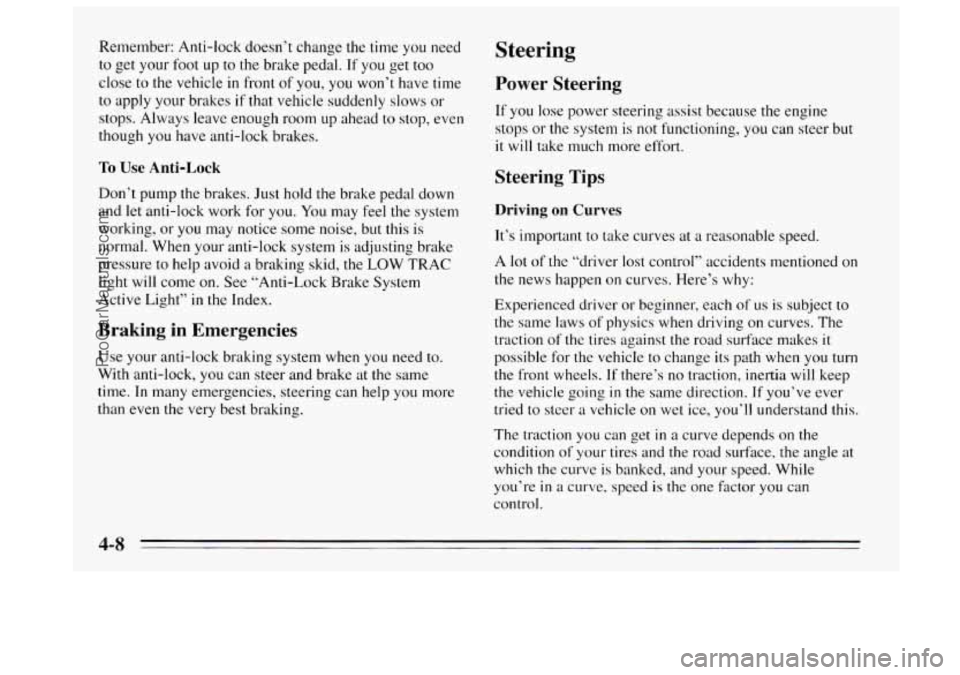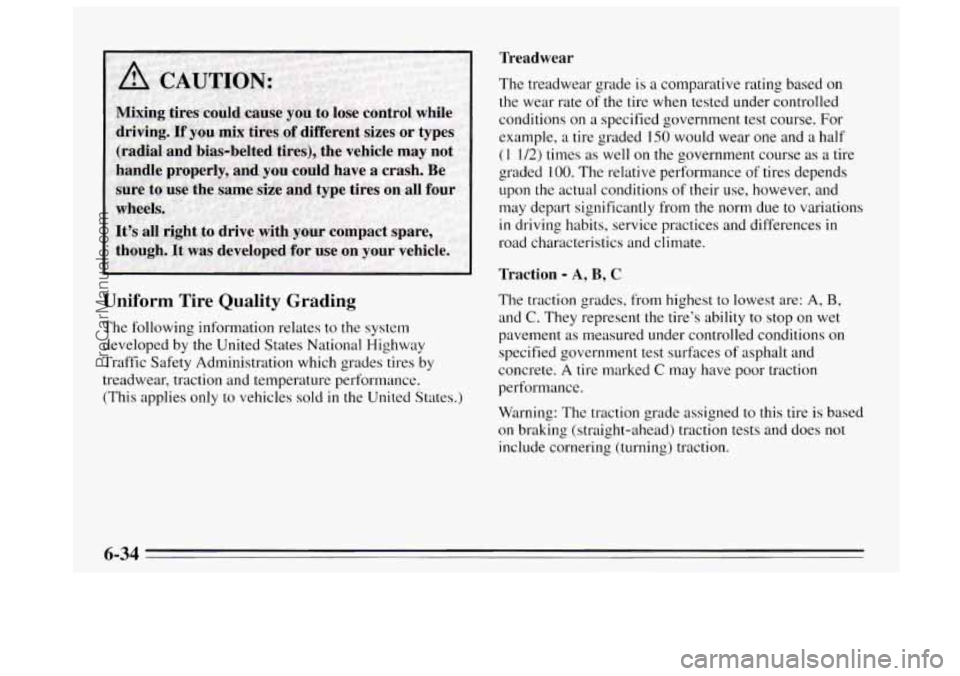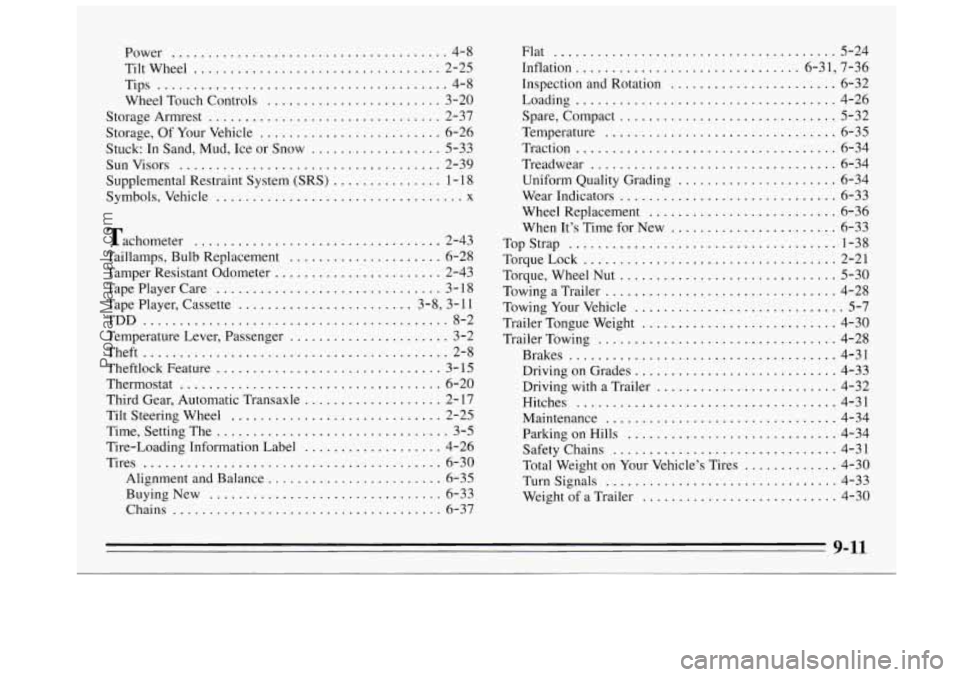traction control BUICK REGAL 1995 Owners Manual
[x] Cancel search | Manufacturer: BUICK, Model Year: 1995, Model line: REGAL, Model: BUICK REGAL 1995Pages: 340, PDF Size: 17.16 MB
Page 146 of 340

Remember: Anti-lock doesn’t change the time you need
to get your foot up to the brake pedal. If you get too
close to the vehicle in front of you, you won’t have time
to apply your brakes
if that vehicle suddenly slows or
stops. Always leave enough room up ahead
to stop, even
though you have anti-lock brakes.
To Use Anti-Lock
Don’t pump the brakes. Just hold the brake pedal down
and let anti-lock work for you. You may feel the system
working, or
you may notice some noise, but this is
normal. When your anti-lock system is adjusting brake
pressure to help avoid a braking skid, the
LOW TRAC
light will come on. See “Anti-Lock Brake System
Active Light”
in the Index.
Braking in Emergencies
Use your anti-lock braking system when you need to.
With anti-lock,
you can steer and brake at the same
time. In many emergencies, steering can help
you more
than even the very best braking.
Steering
Power Steering
If you lose power steering assist because the engine
stops or the system is not functioning, you can steer but
it will take much more effort.
Steering Tips
Driving on Curves
It’s important to take curves at a reasonable speed.
A lot of the “driver lost control” accidents mentioned on
the news happen on curves. Here’s why:
Experienced driver or beginner, each
of us is subject to
the same laws of physics when driving on curves. The
traction
of the tires against the road surface makes it
possible for the vehicle to change its path when you turn
the front wheels. If there’s no traction, inertia will keep
the vehicle going
in the same direction. If you’ve ever
tried to steer
a vehicle on wet ice, you’ll understand this.
The traction you can get in a curve depends on the
condition
of your tires and the road surface, the angle at
which the curve
is banked, and your speed. While
you’re
in a curve, speed is the one factor you can
control.
ProCarManuals.com
Page 151 of 340

A cornering skid and an acceleration skid are best
handled by easing your foot
off the accelerator pedal
If your vehicle starts to slide, ease your foot off the
accelerator pedal and quickly steer the way you want the
vehicle to go.
If you start steering quickly enough, your
vehicle may straighten out. Always be ready for a
second skid
if it occurs.
Of course, traction is reduced when water, snow, ice,
gravel, or other material is on
the road. For safety, you’ll
want to slow down and adjust your driving
to these
conditions.
It is important to slow down on slippery
surfaces because stopping distance will be longer and
vehicle control more limited.
While driving
on a surface with reduced traction, try
your best to avoid sudden steering, acceleration, or
braking (including engine braking by shifting
to a
lower gear). Any sudden changes could cause the tires
to slide. You may
not realize the surface is slippery until
your vehicle is skidding. Learn to recognize warning
clues
-- such as enough water, ice or packed snow on
the road to make a “mirrored surface”
-- and slow down
when
you have any doubt.
Remember: Any anti-lock brake system
(ABS) helps
avoid
only the braking skid.
Driving at Night
Night driving is more dangerous than day driving. One
reason is that some drivers are likely to be impaired
-- by
alcohol
or drugs, with night vision problems, or by fatigue.
Here are some
tips on night driving.
0 Drive defensively.
0 Don’t drink and drive.
4-13
ProCarManuals.com
Page 242 of 340

Uniform Tire Quality Grading
The following information relates to the system
developed by the United States National Highway
Traffic Safety Administration which grades tires by
treadwear, traction and temperature performance.
(This applies only
to vehicles sold in the United States.)
Treadwear
The treadwear grade is a comparative rating based on
the wear rate of the tire when tested under controlled
conditions on
a specified government test course. For
example, a tire graded
150 would wear one and a half
(1 1/2) times as well on the government course as a tire
c- qraded 100. The relative performance of tires depends
upon the actual conditions
of their use, however, and
may depart significantly from the norm due
to variations
in driving habits, service practices and differences in
road characteristics and climate.
Traction - A, B, C
The traction grades, from highest to lowest are: A, B,
and C. They represent the tire’s ability to stop on wet
pavement
as measured under controlled conditions on
specified government test surfaces of asphalt and
concrete.
A tire marked C may have poor traction
performance.
Warning: The traction grade assigned to this tire is based
on braking (straight-ahead) traction tests and does not
include cornering (turning) traction.
6-34
ProCarManuals.com
Page 337 of 340

i
Power ...................................... 4-8
Tiltwheel
.................................. 2-25
Tips
........................................ 4-8
Wheel Touch Controls
........................ 3-20
Storage Armrest
................................ 2-37
Storage. Of Your Vehicle
......................... 6-26
Stuck: In Sand. Mud. Ice or Snow
.................. 5-33
Sunvisors
.................................... 2-39
Supplemental Restraint System (SRS)
............... 1 - 18
Symbols. Vehicle
.................................. x
Tachometer .................................. 2-43
Taillamps. Bulb Replacement
..................... 6-28
Tamper Resistant Odometer
....................... 2-43
Tape Player Care
............................... 3-18
Tape Player. Cassette
........................ 3.8. 3.11
Temperature Lever. Passenger
...................... 3-2
Theft
.......................................... 2-8
Theftlock Feature
............................... 3- 15
Thermostat .................................... 6-20
Third Gear. Automatic Transaxle
................... 2- 17
Tilt Steering Wheel
............................. 2-25
Time. Setting The
................................ 3-5
Tire-Loading Information Label
................... 4-26
Tires
......................................... 6-30
Alignment and Balance
........................ 6-35
BuyingNew
................................ 6-33
Chains
..................................... 6-37
TDD
.......................................... 8-2 Flat
....................................... 5-24
Inflation
............................... 6.31. 7.36
Inspection and Rotation
....................... 6-32
Loading
.................................... 4-26
Spare. Compact
.............................. 5-32
Temperature
................................ 6-35
Traction
.................................... 6-34
Treadwear
.................................. 6-34
Uniform Quality Grading
...................... 6-34
Wear Indicators
.............................. 6-33
Wheel Replacement
.......................... 6-36
When It’s Time for New
....................... 6-33
TorqueLock
................................... 2-21
Torque. Wheel Nut
.............................. 5-30
Towing a Trailer
................................ 4-28
Towing Your Vehicle
............................. 5-7
Trailer Tongue Weight
........................... 4-30
Trailer Towing
................................. 4-28
Brakes
..................................... 4-31
Driving on Grades
............................ 4-33
Driving with a Trailer
......................... 4-32
Hitches
.................................... 4-31
Maintenance
................................ 4-34
Parking on Hills
............................. 4-34
Safety Chains
............................... 4-31
Turnsignals
................................ 4-33
Weight of a Trailer
........................... 4-30
TopStrap
..................................... 1-38
Total Weight
on Your Vehicle’s Tires ............. 4-30
9-11
ProCarManuals.com